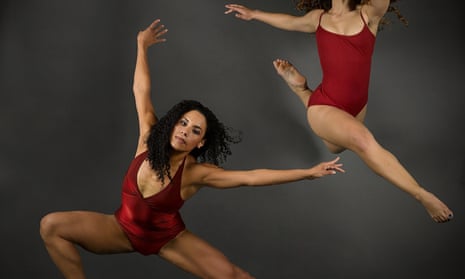Even before Donald Trump was using the presidential pulpit to create division, David Herrera was battling racism from a seemingly unusual place – choreography in modern dance. Before 2016, Herrera’s company dancers were calling out the idiocy of racial profiling: at one point they physically tagged audience members with ready-made name tags denoting their perceived race.
But for this weekend’s fifth annual Festival of Latin American Choreographers (Flacc) in San Francisco, the California native has changed tactics.
Herrera said: “This is the calmest piece I’ve done. I’m exhausted with what’s going on in the states, [so the dance] is about finding empathy in a tumultuous time, about surviving turmoil, connecting with a bridge as opposed to building a wall.”
In his Flacc program, part of a production called Resurrection of Everyday People, empathy is expressed by dancers – almost all women of color – internalizing their personal turmoil.
In the battle for the country’s soul, he wants to connect to people’s common humanity – as he does with conservative Texan family members.
“I want to be able to present myself in a way they can understand,” he said. “Recently I’ve had conversations with conservatives that were tactful and real. I could feel people opening up.”
The David Herrera Performance Company is one of nine artists at the three-day festival exploring how political, economic, racial, and religious tensions impact Latinx communities – and how they can survive them. Pointedly, the event takes place in the city’s predominantly Latinx Mission district, a neighborhood currently enduring a wave of gentrification, and in a venue trying to stay afloat with increasing rental costs.
Other artists invited from Peru, Mexico, Honduras, the USand elsewhere echo Herrera’s thinking.

Mexican Fabiola Guillen is performing a dance about the Catholic church’s impact on “the limits to gender expression in dance and how these ideologies are related to anti-women sentiments” there, according to Flacc co-director Juan Manuel Aldape Munoz. Randy Reyes, collaborating with performance artist Stephanie Hewett, will explore how ecological disaster impacts black and brown bodies in the US. The duo will dance on a long runway made out of aluminum foil, preventing water they carry from touching the ground. It’s a commentary on surviving with fewer resources, just like his grandmother in Guatemala.
“She lives in a zone that doesn’t get running water with frequency,” he said. “Oftentimes folks in the neighborhood save water barrels when it’s present to ensure they have enough of a supply to get through the week.”
The engagement of modern dance with the post-migrant experience is a recent and growing trend. A dance theater in Germany has been developed by Turkish migrants based on immigration policies, and in Italy and in the US, academic and free programs have sought to connect with African immigrants through dance.
But Liz Duran Boubion, the Flacc director who led its growth from an unfunded community project, said it’s important for the dance community to reflect on its history of poor structural support for minorities. This call has been repeated by others, such as Virginia Johnson, the artistic director of Dance Theatre of Harlem, and the famed ballet dancer Misty Copeland. But full awareness is still lacking.
People need access to “multiple dance styles, take innovative risks, and speak in their native tongues to an audience and organization that understands and receives them”, said Duran Boubion.
The Festival of Latin American Contemporary Choreographers (¡FLACC!) is at Dance Mission Theater, San Francisco, Fri to Sun
